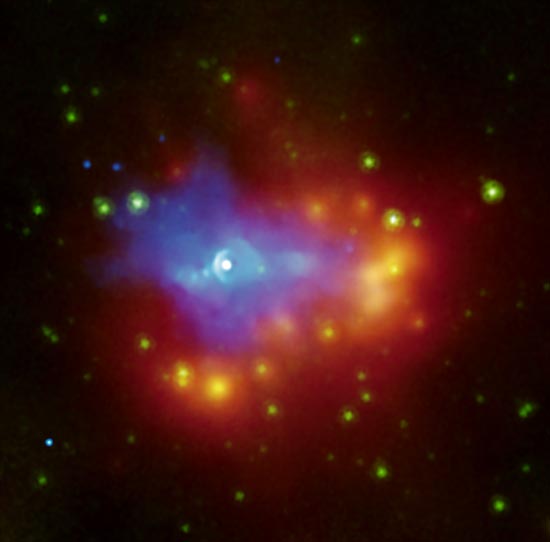Star's Corpse Illuminated by High-Energy Wind

The dusty remains of a collapsed star can be seen flyingpast and engulfing a nearby family of stars in new images from NASA's Chandraand Spitzer space telescopes.
The composite view of the stellar remains (dubbed, "G54.1+0.3")includes observations from the Chandra X-ray Observatory in blue, with greenand red-yellow regions studied by the Spitzer Space Telescope. The white sourcenear the center of the image is a dense, rapidly rotating neutron star, or"pulsar,"left behind after a core-collapse supernova explosion.
The pulsar generates a wind of high-energy particles ? seenin the Chandraphotos ? that expands into the surrounding environment, illuminating thematerial ejected in the supernova explosion.
The infrared shell that surrounds the pulsar wind is made upof gas and dust that condensed out of debris from the supernova. As the colddust expands into the surroundings, it is heated and lit up by the stars in thecluster so that it is observable in the infrared. The dust closest to the starsis the hottest and is seen to glow in yellow in the image.
Some of the dust is also being heated by the expandingpulsar wind as it overtakes the material in the shell.
The unique environment into which this supernovaexploded makes it possible for astronomers to observe the condensed dust fromthe supernova that is usually too cold to emit in the infrared. Without thepresence of the stellar cluster, it would not be possible to observe this dustuntil it becomes energized and heated by a shock wave from the supernova.
However, the very action of such shock heating would destroymany of the smaller dust particles. In G54.1+0.3, astronomers are observingpristine dust before any such destruction.
Breaking space news, the latest updates on rocket launches, skywatching events and more!
The nature and quantity of dust produced in supernovaexplosions is a long-standing mystery, and G54.1+0.3 supplies an importantpiece to the puzzle.
- Top 10Star Mysteries
- Images:Highlights from Chandra's Mission
- What Is aSupernova?

Space.com is the premier source of space exploration, innovation and astronomy news, chronicling (and celebrating) humanity's ongoing expansion across the final frontier. Originally founded in 1999, Space.com is, and always has been, the passion of writers and editors who are space fans and also trained journalists. Our current news team consists of Editor-in-Chief Tariq Malik; Editor Hanneke Weitering, Senior Space Writer Mike Wall; Senior Writer Meghan Bartels; Senior Writer Chelsea Gohd, Senior Writer Tereza Pultarova and Staff Writer Alexander Cox, focusing on e-commerce. Senior Producer Steve Spaleta oversees our space videos, with Diana Whitcroft as our Social Media Editor.
